Actually Useful Writing Books
Kate Flora: Over the years, I accumulated quite a library of reference books related to writing, to crime writing in particular, and to crime investigations of all sorts. I never stop acquiring books that someone I regard as credible has suggested. This week I added The Bestseller Code: anatomy of a blockbuster novel. I usually find these unsatisfying but I’ll give it a try. For writers beginning to crime writing journey, Hallie Ephron’s Writing and Selling Your Mystery Novel is a fabulous reference, and one I return to time after time. Also an excellent reference is How to Write a Mystery: a Handbook from Mystery Writers of America. And for writers learning to embrace revision, Elizabeth Lyon’s Manuscript Makeover: Revision Techniques No Fiction Writer Can Afford To Ignore. Of course, I also have a zillion books on injuries, criminal psychology, practical homicide investigation, writing suspense, etc.
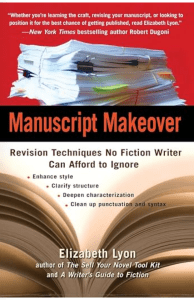


Kaitlyn Dunnett/Kathy Lynn Emerson: My “how-to” book collection is pitifully small and most of it dates back to the 1970s and 1980s when I was first trying to learn the craft. Those books are both out of print and out of date. So, for what it’s worth, I’m going to plug the writing book I wrote and which I recently reissued in a slightly revised and updated trade paperback edition. It’s also available as an e-book.
HOW TO WRITE KILLER HISTORICAL MYSTERIES won the 2008 Agatha Award for best nonfiction. Marv Lachman, reviewing it in Deadly Pleasures, described it as “the best book about writing mysteries that I have ever read.” Most of my updates are in the sections on self-publishing and marketing, where there have been massive changes in the industry since 2008. All the good stuff is the same.
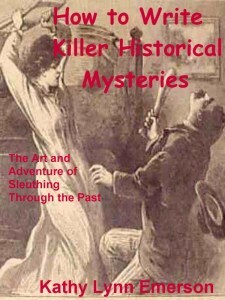
The original version (which has a different cover) was written while I was still writing my Face Down series, featuring Susanna, Lady Appleton, sixteenth-century gentlewoman, herbalist, and sleuth, and had just published the fourth book in my Diana Spaulding 1888 Quartet. It’s my take on writing historical mysteries, but it also contains input from many other writers of historical mysteries. They include longtime friends like Sharan Newman, Rhys Bowen, and the late Carole Nelson Douglas, who offer their insights into what it takes to mix history with mystery, as well several writers I’ve never met (Lindsay Davis and Kerry Greenwood, to name just two), who were also extremely generous in offering advice and letting me quote them on a variety of historical-mystery-writing topics.
Kait Carson: Two of my bookshelves are filled with writing books. Some (not many) I’ve read. Mostly, I run my finger across the spines and hope to absorb whatever I need at that moment. There are three I return to again and again. The Emotional Thesaurus by Angela Akerman and Becca Puglisi, helps to vary up the language and provides great show don’t tell language. Chris Roerden’s Don’t Murder your Mystery is the last edit check before the book is ready for prime time beta readers. On Writing by Stephen King. Not for the craft advice, but for the shot of energy it gives me when I’m flagging.
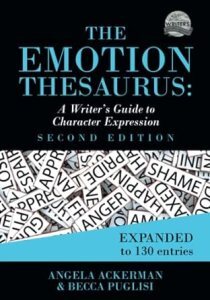
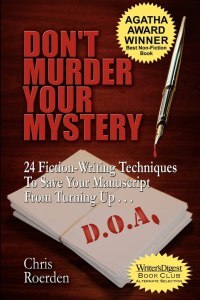

John Clark: For beginning writers, high school students and local adult education classes, I still think What If? Writing Exercises for Fiction Writers Paperback – November 20, 1991 by Anne Bernays (Author), Pamela Painter (Author) is an excellent book to use.

Matt Cost has always been an odd duck. I’ve never read books on writing as I don’t believe that it can be taught, only practiced, honed, and improved through the process. My fear is that writing craft books will swerve me from my own style and take my unique style and mold it into a Christmas cookie. But I do use a variety of books for research! Books on voodoo, cults, Brooklyn, New Orleans, the Civil War, and Joshua Chamberlain. Bonus points if you can match the research books to my written novels.

Jule Selbo here. I have read a lot of books on story structure – most that focused on screenwriting since that was my profession for many years (books that helped me make my living as a writer which was the best thing ever – for me).

Syd Field’s book, written in 1979, was the first one I grabbed from a bookstore when my playwriting agent told me I had to write for tv and film so “we” could make money. It was helpful – he laid out story structure in a very comprehensible way – and I also got to know Syd a bit and he was a generous with his knowledge.
 Then I went backwards in time and found France Marion’s book (1937, she won an Academy Award for her screenplay – The Champ – in 1931, was best buds with Mary Pickford, wrote comedies and dramas and movies that help change the prison system (The Big House 1930). Her approach was simple, made a big impression on me.
Then I went backwards in time and found France Marion’s book (1937, she won an Academy Award for her screenplay – The Champ – in 1931, was best buds with Mary Pickford, wrote comedies and dramas and movies that help change the prison system (The Big House 1930). Her approach was simple, made a big impression on me.
 Clare Beranger’s – (1950 book, she was a screenwriter in early Hollywood and then started what became USC Film School). Smart, incisive and
Clare Beranger’s – (1950 book, she was a screenwriter in early Hollywood and then started what became USC Film School). Smart, incisive and
 Then back to Chris Vogler (who took Joseph Campbell’s fabulous work and adapted Campbell’s story evolution and ideas to screenwriting). Everything was helpful – for different reasons. (I think Vogler’s structure layout is best for the classic superhero and epic film stories.) I even wrote two “how-to” books for screenwriters (structure book (2010) and story genre book (2014) after working in the craft/business for few decades and I still find them helpful because they reflect on I landed on a way to approach story that made sense to me.
Then back to Chris Vogler (who took Joseph Campbell’s fabulous work and adapted Campbell’s story evolution and ideas to screenwriting). Everything was helpful – for different reasons. (I think Vogler’s structure layout is best for the classic superhero and epic film stories.) I even wrote two “how-to” books for screenwriters (structure book (2010) and story genre book (2014) after working in the craft/business for few decades and I still find them helpful because they reflect on I landed on a way to approach story that made sense to me.

 When I moved into writing novels, I became obsessed with studying how writers could “keep me reading even when I had other things I needed to do” . For me, there are so many books that are excellent, and then there are the ones that I am not sure if they are excellent – but they drag me back to my reading chair even when I am supposed to be doing something else. And I love trying figure out how the writers of those books “do that”. Is it their building of characters? Filling out the life of the people/the crime/ the reasoning/the world? Right now – I read and read mysteries/crime novels and re-read the ones that I can’t put down and try to suss out the reasons…
When I moved into writing novels, I became obsessed with studying how writers could “keep me reading even when I had other things I needed to do” . For me, there are so many books that are excellent, and then there are the ones that I am not sure if they are excellent – but they drag me back to my reading chair even when I am supposed to be doing something else. And I love trying figure out how the writers of those books “do that”. Is it their building of characters? Filling out the life of the people/the crime/ the reasoning/the world? Right now – I read and read mysteries/crime novels and re-read the ones that I can’t put down and try to suss out the reasons…
Rob Kelley: As is the case for many writers, Anne Lamott’s Bird by Bird was influential for me with her concept of the shitty first draft. There is something so freeing about getting out of your own way and getting words down on paper. But my new favorite writing advice book isSeven Drafts by Allison K. Wilson, primarily because it helped me have a path for how to fix everything without trying to fix it all at once. She outlines seven drafts: The Vomit Draft (first draft), then describes subsequent ones on plot, character, technical matters, copy editing, beta reading, and editor reading. In working on my most recent novel, I used them all, plus a few more that helped correct mistakes I always make. It was a great way to have a plan to work against when facing the chaos of a work in progress!
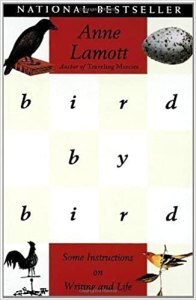
Maggie Robinson: I probably should read each and every one of these. I only took one writing class in college, Persuasive Writing. I don’t believe I ever persuaded anyone of anything, and whatever textbook we used is long gone. Over the years I’ve sat through numerous craft workshops with book suggestions, but like Matt have resisted reading them. Maybe I’m just lazy. However, I can second Kait’s rec of Stephen King’s On Writing, even if I am still shamelessly larding my prose with adverbs.
Lea Wait's Blog
- Lea Wait's profile
- 509 followers



